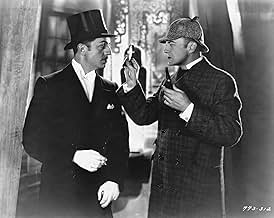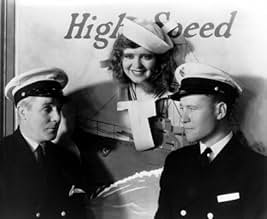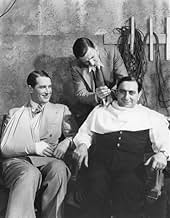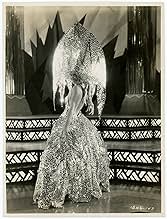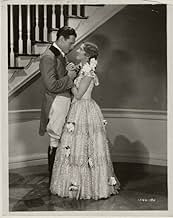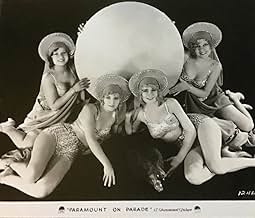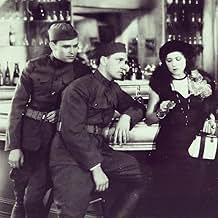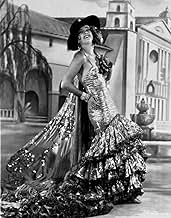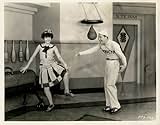Füge eine Handlung in deiner Sprache hinzuA musical revue that has Paramount stars and contract-players doing unrelated short sketches and elaborately staged song-and-dance numbers like a duet on a giant cuckoo clock and Clara Bow s... Alles lesenA musical revue that has Paramount stars and contract-players doing unrelated short sketches and elaborately staged song-and-dance numbers like a duet on a giant cuckoo clock and Clara Bow singing aboard a navy vessel.A musical revue that has Paramount stars and contract-players doing unrelated short sketches and elaborately staged song-and-dance numbers like a duet on a giant cuckoo clock and Clara Bow singing aboard a navy vessel.
- Regie
- Drehbuch
- Hauptbesetzung
- Auszeichnungen
- 3 wins total
Charles 'Buddy' Rogers
- Buddy Rogers - Episode 'Love Time'
- (as Buddy Rogers)
Empfohlene Bewertungen
"Paramount On Parade" is both a musical revue and a collection of skits by Hollywood stars who can sing and some who cannot. The entertainment value is uneven as some of their stints in front of the camera range from pretty good to mediocre, from Maurice Chevalier to George Bancroft, whose forte was gangster roles. The movie was an excuse for Paramount to showcase as much of their stable of stars as they could assemble, and there were quite a lot of them. I understand that there were a spate of star revue-type pictures produced around the start of the sound era, and this was another one in that mold.
The main reason to see this picture in 2010, I found, was as a museum piece, watching old stars that I had only heard of. Hadn't seen much of Mitzi Green to speak of, ditto Skeets Gallagher, and had never seen Harry Green before. From that standpoint it was fascinating, but maybe not for moviegoers older than me. There was a good skit with four old-time movie sleuths, Warner Oland, William Powell, Clive Brook and Eugene Palette (who was more of a movie dim-witted cop).
On the IMDb site it is clocked at 77 minutes but at Capitolfest in Rome,N.Y. (8/10), a 102 minute 35mm print restored by the UCLA film department was shown which made it extra special.
The main reason to see this picture in 2010, I found, was as a museum piece, watching old stars that I had only heard of. Hadn't seen much of Mitzi Green to speak of, ditto Skeets Gallagher, and had never seen Harry Green before. From that standpoint it was fascinating, but maybe not for moviegoers older than me. There was a good skit with four old-time movie sleuths, Warner Oland, William Powell, Clive Brook and Eugene Palette (who was more of a movie dim-witted cop).
On the IMDb site it is clocked at 77 minutes but at Capitolfest in Rome,N.Y. (8/10), a 102 minute 35mm print restored by the UCLA film department was shown which made it extra special.
You get to see dozens of early talkie stars in this hodgepodge. The short "drama" sequences and most of the "comedy" sequences are awful, but the singing and dancing routines are tops. My favorites are the "I'm in Training for You" routine (Jack Oakie and Zelma O'Neal), the "Dancing to Save Your Soul" routine (Nancy Carroll and an uncredited Al Norman - the great deadpan rubberlegs dancer), Maurice Chevalier singing "All I Want is Just One" and "Sweeping the Clouds Away" and little Mitzi Green imitating Chevalier.
Sad to say I recently saw an abbreviated version of Paramount On Parade with about only 60% of the numbers and acts in the edited version I saw. Fortunately I do remember seeing the whole film in years gone by.
Paramount's biggest star in those days was Maurice Chevalier who gets to be in three numbers, one of them being the finale. He also had the biggest hits of the show with All I Want Is Just One Girl and Up On Top Of A Rainbow. His third number the Poor Apache is an Apache number if Mack Sennett had choreographed it.
The White Mountain studio made both an English and French version and in the French version Jeanette MacDonald was mistress of ceremonies as opposed to comedian Skeets Gallagher for the English. She also was given a number in the French one that we in America weren't privileged to hear. I'm told it's quite lovely.
William Powell and Clive Brook play Philo Vance and Sherlock Holmes in a murder mystery satire where they annoy Warner Oland as Fu Manchu with insisting on dragging in other suspects. Eugene Palette and Jack Oakie are also in the skit as well.
Cut out of the version I just saw was Dennis King, Broadway star who had just repeated his role as Francois Villon in The Vagabond King. That film doesn't hold up well for a number of reasons, but his number Nichavo in Paramount On Parade is a stirring song that King's virile baritone takes to easily. King did much better on stage than on the screen although he scored very well in his next film with Laurel and Hardy, Fra Diavolo.
The finale is Maurice Chevalier with Up On Top Of A Rainbow done with a hundred chorus girls as well. The song and Maurice are fine, but these kind of numbers really needed Busby Berkeley to show how its done.
I'm a big old sucker for these all star films which had a brief run during the early days of sound and then were revived during World War II as morale boosters. I only wish a complete version was available out there.
Paramount's biggest star in those days was Maurice Chevalier who gets to be in three numbers, one of them being the finale. He also had the biggest hits of the show with All I Want Is Just One Girl and Up On Top Of A Rainbow. His third number the Poor Apache is an Apache number if Mack Sennett had choreographed it.
The White Mountain studio made both an English and French version and in the French version Jeanette MacDonald was mistress of ceremonies as opposed to comedian Skeets Gallagher for the English. She also was given a number in the French one that we in America weren't privileged to hear. I'm told it's quite lovely.
William Powell and Clive Brook play Philo Vance and Sherlock Holmes in a murder mystery satire where they annoy Warner Oland as Fu Manchu with insisting on dragging in other suspects. Eugene Palette and Jack Oakie are also in the skit as well.
Cut out of the version I just saw was Dennis King, Broadway star who had just repeated his role as Francois Villon in The Vagabond King. That film doesn't hold up well for a number of reasons, but his number Nichavo in Paramount On Parade is a stirring song that King's virile baritone takes to easily. King did much better on stage than on the screen although he scored very well in his next film with Laurel and Hardy, Fra Diavolo.
The finale is Maurice Chevalier with Up On Top Of A Rainbow done with a hundred chorus girls as well. The song and Maurice are fine, but these kind of numbers really needed Busby Berkeley to show how its done.
I'm a big old sucker for these all star films which had a brief run during the early days of sound and then were revived during World War II as morale boosters. I only wish a complete version was available out there.
I've just watched the current restoration and can add some information to the 2002 review.
The footage of the opening "Showgirls on Parade" sequence is missing but the sound survives.
The sound disc for "Isadore the Toreador" has been located (only a few days ago) and will be put into the next restoration with the surviving Technicolor footage..
Nino Martini's number is now complete, and in Technicolor.
The "Dream Girl" Technicolor footage survives but the sound is missing.
The "Gallows Scene" is missing most of the sound except for Dennis King's song.
The footage of the opening "Showgirls on Parade" sequence is missing but the sound survives.
The sound disc for "Isadore the Toreador" has been located (only a few days ago) and will be put into the next restoration with the surviving Technicolor footage..
Nino Martini's number is now complete, and in Technicolor.
The "Dream Girl" Technicolor footage survives but the sound is missing.
The "Gallows Scene" is missing most of the sound except for Dennis King's song.
This was the type of variety show which most of the studios made which was popular in the early days of sound. In this case, the film consists of various short sketches, including musical numbers, comedy bits, and even a dramatic scene. The stars include Maurice Chevalier, Clara Bow, Ruth Chatterton, Fredric March, Gary Cooper, George Bancroft, Jack Oakie, Skeets Gallagher, Buddy Rogers, Kay Francis, Jean Arthur, Mary Brian, Fay Wray, Evelyn Brent, Leon Errol, William Powell, Warner Oland, Clive Brook, Eugene Pallette, Lillian Roth, Stu Erwin, Helen Kane, Nancy Carroll, and Mitzi Green.
Paramount also enlisted a posse of directors, including Edmund Goulding, Dorothy Arzner, Ernst Lubitsch, Rowland V. Lee, Victor Scherzinger, and more. Several of the film's segments, including a few in early Technicolor, were missing from the copy that I watched. In fact, the segment featuring Cooper, Brian, Arthur and Wray only consisted of the intro. My favorite segments include the very silly detective bit with Clive Brook as Sherlock Holmes, Powell as Philo Vance, and Oland as Fu Manchu; Chevalier and Brent in a lover's quarrel; Ruth Chatterton as a sad French prostitute who sings a song to American G. I.s (including March) about to return home from WWI; and a comedy piece with Chevalier as a gendarme patrolling a park popular with lovers. Most of the song and dance numbers were largely forgettable, though. Still, it was nice to see for a different look at the various stars.
Paramount also enlisted a posse of directors, including Edmund Goulding, Dorothy Arzner, Ernst Lubitsch, Rowland V. Lee, Victor Scherzinger, and more. Several of the film's segments, including a few in early Technicolor, were missing from the copy that I watched. In fact, the segment featuring Cooper, Brian, Arthur and Wray only consisted of the intro. My favorite segments include the very silly detective bit with Clive Brook as Sherlock Holmes, Powell as Philo Vance, and Oland as Fu Manchu; Chevalier and Brent in a lover's quarrel; Ruth Chatterton as a sad French prostitute who sings a song to American G. I.s (including March) about to return home from WWI; and a comedy piece with Chevalier as a gendarme patrolling a park popular with lovers. Most of the song and dance numbers were largely forgettable, though. Still, it was nice to see for a different look at the various stars.
Wusstest du schon
- WissenswertesOf the original 20 individual sequences, seven of them were filmed in 2-strip Technicolor: the opening sequence: 'Showgirls on Parade', Nino Martini's 'Come Back to Sorrento,' Harry Green's 'Isadore the Toreador' with Kay Francis, Dennis King's 'Nitchavo,' 'Girl of My Dreams', with Richard Arlen, Jean Arthur, Mary Brian, Virginia Bruce, Gary Cooper, James Hall, Phillips Holmes, David Newell, Joan Peers, and Fay Wray, of which only the B&W introduction survives, and the 'Rainbow Revels' finale featuring Maurice Chevalier singing 'Sweeping the Clouds Away', which also survives in B&W. The total Technicolor footage was 2517 feet (768 m), or about 28 minutes.
- PatzerThe re-release opening credits credit producer Jesse L. Lasky as "Jessie" L. Lasky.
- Zitate
Jack Oakie: It's a mystery play written especially for me!
- Alternative VersionenVersion for distribution of the original film in Romania, titled Parada Paramount (1930) included additional sketches by Romanian actors Ion Ian-Covescu and Pola Iliescu
- VerbindungenAlternate-language version of Parada Paramount (1930)
- SoundtracksAll I Want Is Just One Girl
Music by Richard A. Whiting
Lyrics by Leo Robin
Sung by Maurice Chevalier
Sung also by Mitzi Green
Top-Auswahl
Melde dich zum Bewerten an und greife auf die Watchlist für personalisierte Empfehlungen zu.
- How long is Paramount on Parade?Powered by Alexa
Details
- Erscheinungsdatum
- Herkunftsland
- Sprachen
- Auch bekannt als
- Paramount Şeref Geçidi
- Drehorte
- Produktionsfirma
- Weitere beteiligte Unternehmen bei IMDbPro anzeigen
- Laufzeit1 Stunde 42 Minuten
- Farbe
- Seitenverhältnis
- 1.20 : 1
Zu dieser Seite beitragen
Bearbeitung vorschlagen oder fehlenden Inhalt hinzufügen

Oberste Lücke
By what name was Paramount on Parade (1930) officially released in India in English?
Antwort
